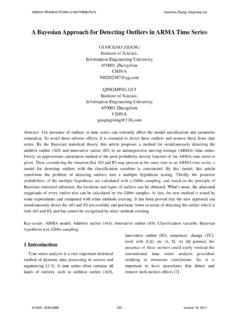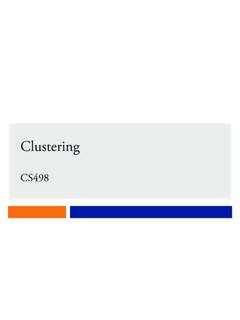Transcription of Outliers: The Story of Success
1 outliers : The Story of SuccessMalcolm GladwellOutliers: The Story ofSuccess Author: Malcolm GladwellCategory: Art of LivingOther name: Diana : : 28-October-2012 Page 1/126 : The Story of SuccessMalcolm Gladwell INTRODUCTION The Roseto Mystery THESE PEOPLE WERE DYING OF OLD AGE. THAT'S IT. out-li-er \-,l (-9)r\ noun i: something that is situated away from or classed differently from a mainor related body 2: a statistical observation that is markedly different in value from the others ofthe sample. Roseto Valfortore lies one hundred miles southeast of Rome in the Apennine foothills of theItalian province of Foggia. In the style of medieval villages, the town is organized around a largecentral square.
2 Facing the square is the Palazzo Marchesale, the palace of the Saggese family,once the great landowner of those parts. An archway to one side leads to a church, theMadonna del CarmineOur Lady of Mount Carmine. Narrow stone steps run up the hillside,flanked by closely clustered two- Story stone houses with red-tile roofs. For centuries, the paesani of Roseto worked in the marble quarries in the surrounding hills, orcultivated the fields in the terraced valley below, walking four and five miles down the mountainin the morning and then making the long journey back up the hill at night. Life was hard. Thetownsfolk were barely literate and desperately poor and without much hope for economicbetterment until word reached Roseto at the end of the nineteenth century of the land ofopportunity across the ocean.
3 In January of 1882, a group of eleven Rosetansten men and one boyset sail for New spent their first night in America sleeping on the floor of a tavern on Mulberry Street, inManhattan's Little Italy. Then they ventured west, eventually finding jobs in a slate quarry ninetymiles west of the city near the town of Bangor, Pennsylvania. The following year, fifteenRosetans left Italy for America, and several members of that group ended up in Bangor as well,joining their compatriots in the slate quarry. Those immigrants, in turn, sent word back toRoseto about the promise of the New World, and soon one group of Rosetans after anotherpacked their bags and headed for Pennsylvania, until the initial stream of immigrants became aflood.
4 In 1894 alone, some twelve hundred Rosetans applied for passports to America, leavingentire streets of their old village abandoned. The Rosetans began buying land on a rocky hillside connected to Bangor by a steep, ruttedwagon path. They built closely clustered two- Story stone houses with slate roofs on narrowstreets running up and down the hillside. They built a church and called it Our Lady of MountCarmel and named the main street, on which it stood, Gari- baldi Avenue, after the great hero of Italian unification. In the beginning, they called their townNew Italy. But they soon changed it to Roseto, which seemed only appropriate given thatPage 2/126 : The Story of SuccessMalcolm Gladwellalmost all of them had come from the same village in Italy.
5 In 1896, a dynamic young priest by the name of Father Pasquale de Nisco took over at OurLady of Mount Carmel. De Nisco set up spiritual societies and organized festivals. Heencouraged the townsfolk to clear the land and plant onions, beans, potatoes, melons, and fruittrees in the long backyards behind their houses. He gave out seeds and bulbs. The town came tolife. The Rosetans began raising pigs in their backyards and growing grapes for homemadewine. Schools, a park, a convent, and a cemetery were built. Small shops and bakeries andrestaurants and bars opened along Garibaldi Avenue. More than a dozen factories sprang upmaking blouses for the garment trade.
6 Neighboring Bangor was largely Welsh and English, andthe next town over was overwhelmingly German, which meantgiven the fractious relationshipsbetween the English and Germans and Italians in those yearsthat Roseto stayed strictly forRosetans. If you had wandered up and down the streets of Roseto in Pennsylvania in the firstfew decades after 1900, you would have heard only Italian, and not just any Italian but theprecise southern Foggian dialect spoken back in the Italian Roseto. Roseto, Pennsylvania, wasits own tiny, selfsufficient worldall but unknown by the society around itand it might well haveremained so but for a man named Stewart Wolf. Wolf was a physician.
7 He studied digestion and the stomach and taught in the medical school atthe University of Oklahoma. He spent his summers on a farm in Pennsylvania, not far fromRoseto although that, of course, didn't mean much, since Roseto was so much in its own worldthat it was possible to live in the next town and never know much about it. One of the timeswhen we were up there for the summerthis would have been in the late nineteen fifties I wasinvited to give a talk at the local medical society, Wolf said years later in an interview. Afterthe talk was over, one of the local doctors invited me to have a beer. And while we were havinga drink, he said, 'You know, I've been practicing for seventeen years.
8 I get patients from allover, and I rarely find anyone from Roseto under the age of sixty-five with heart disease.' Wolf was taken aback. This was the 1950s, years before the advent of cholesterol-loweringdrugs and aggressive measures to prevent heart disease. Heart attacks were an epidemic in theUnited States. They were the leading cause of death in men under the age of sixty-five. It wasimpossible to be a doctor, common sense said, and not see heart disease. Wolf decided to investigate. He enlisted the support of some of his students and colleagues fromOklahoma. They gathered together the death certificates from residents of the town, going backas many years as they could.
9 They analyzed physicians' records. They took medical histories andconstructed family genealogies. We got busy, Wolf said. W e decided to do a preliminarystudy. We started in nineteen sixty-one. The mayor said, 'All my sisters are going to help you/He had four sisters. He said, 'You can have the town council room/ I said, 'Where are yougoing to have council meetings?' He said, 'Well, we'll postpone them for a while/ The ladieswould bring us lunch. We had little booths where we could take blood, do EKGs. We were therefor four weeks. Then I talked with the authorities. They gave us the school for the summer. Weinvited the entire population of Roseto to be tested.
10 The results were astonishing. In Roseto, virtually no one under fifty-five had died of a heartattack or showed any signs of heart disease. For men over sixty-five, the death rate from heartdisease in Roseto was roughly half that of the United States as a whole. The death rate from allcauses in Roseto, in fact, was 30 to 35 percent lower than 3/126 : The Story of SuccessMalcolm Gladwell Wolf brought in a friend of his, a sociologist from Oklahoma named John Bruhn, to help him. Ihired medical students and sociology grad students as interviewers, and in Roseto we wenthouse to house and talked to every person aged twenty-one and over, Bruhn remembers. Thishappened more than fifty years ago, but Bruhn still had a sense of amazement in his voice as hedescribed what they found.









